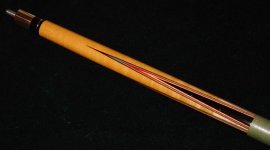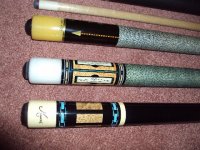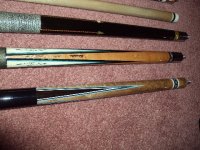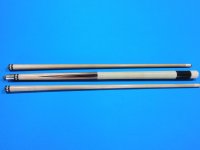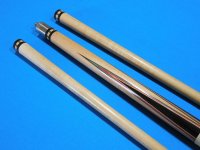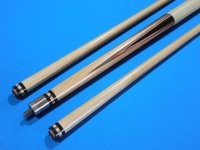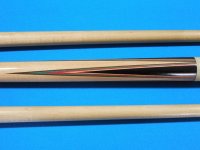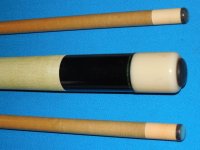This is the only Palmer I've seen with a true Szamboti Bicentennial blank. I once doubted
they even existed, but when I questioned it a few years ago, Barry Szamboti e-mailed
me and told me he helped make the blanks himself when he was a kid. We wondered what
happened to the cues.
Palmer was originally planning to have a "Bicentennial" cue line, joining the bandwagon
of commemoratives and collectibles marketed for the USA's 200th Birthday celebration in
1975-1976. They decided on using Szamboti blanks that were in a red, white, blue and
black color scheme. The blanks were made and delivered, but Palmer scrapped the Bicentennial
cue line idea. The few cues they made, they sold off, then used the Szamboti blanks for
other cues in the years that followed. I suspect they were used in some of the Pete Margo
line cues later on, but haven't confirmed it.
How this cue came to light was the original owner brought the cue to Pete Tascarella to
put a new butt cap on it and build some shafts. Pete identified the Palmer as a Szamboti
blanked cue. Pete knows Szamboti's really well because of his work on Balabushka's. The
cue was brought to my attention by a collector who wanted to purchase it, so I researched
it for him. I checked with the original owner, and sure enough, he bought the cue in 1976!
We checked with Barry, and he confirmed it was the elusive Bicentennial blank. Later on,
when the deal fell through, and I bought the cue.
The original owner bought this cue from Palmer in 1976. It's very similar to a Model 11
from the 3rd catalog, which was introduced before this time, but notice the straight
black collar. What doesn't show up is the butt, which has a forearm-matching thin
blue ring.
I am putting these pictures up for everyone to see the differences. The Szamboti blanked
cue is the upper cue in the close ups. The other cue is a Palmer 3rd catalog Model 11.
While the color scheme is similar, the differences are 1) Szamboti colors are more subdued
2) The veneer work is superior, nearly perfect miters 3) the veneers are thicker on the
Szamboti 4) sometimes the points are longer, but not always. There are long points on
many of the late 1970's Palmer's too.
Anyway, I'm glad this example surfaced, if for nothing else than to satisfy my, and
other collectors, curiosity. The photos don't show it, but the Szamboti has very dark inner points, the Palmer has mixed brown and black (Macassar).
Chris
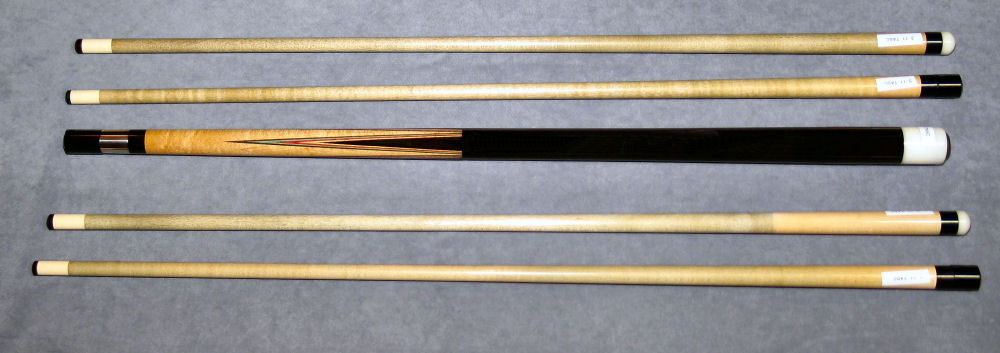
Here's the full cue with 2 Palmer shafts and two Tascarella shafts. The wrap is thin black nylon, tightly pressed.
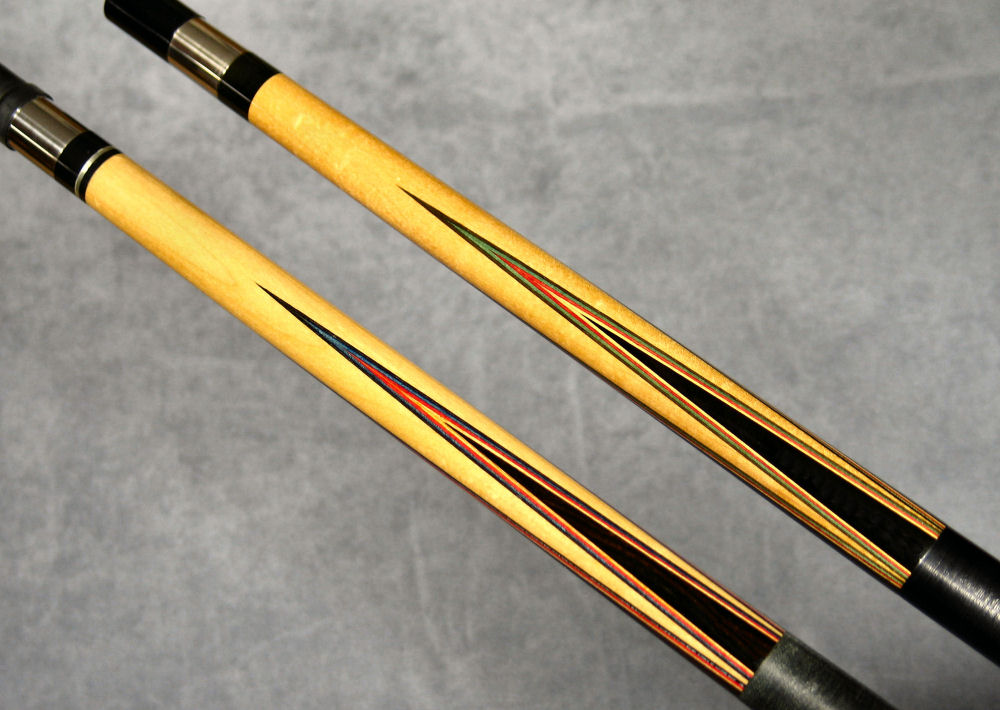
The upper cue is the Szamboti Bicentennial blank, subdued colors, clean veneer work, the lower cue is a Model 11 from the 3rd catalog, made around the same time with a standard forearm.
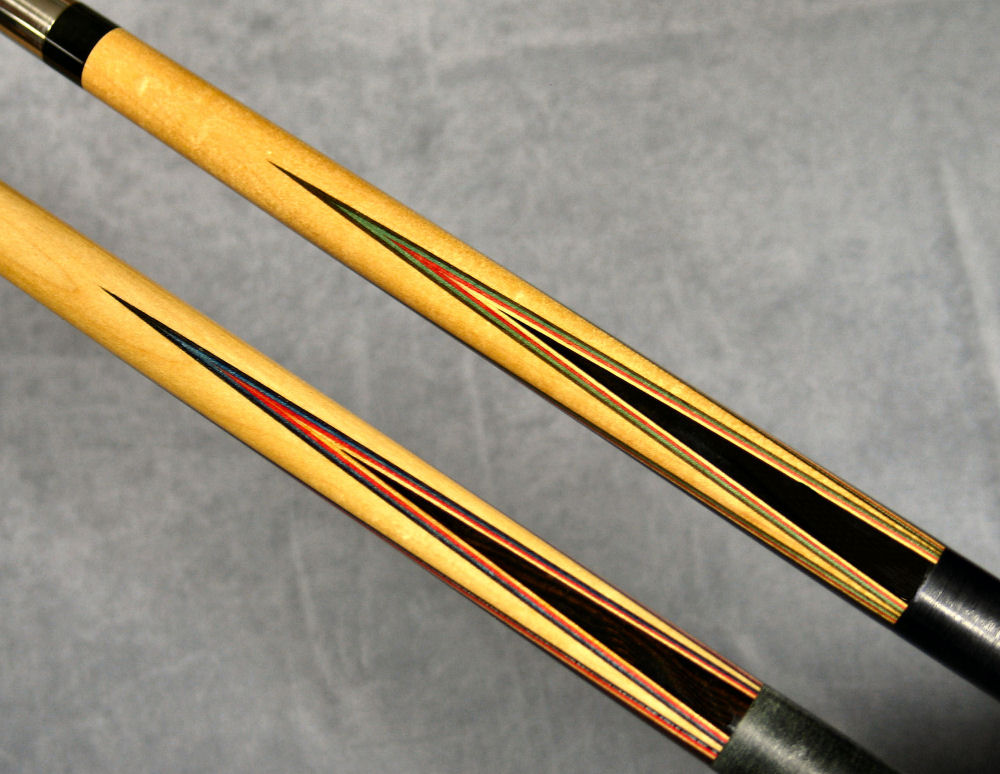
Here you can see the difference in veneer thickness and the quality of the miters. When they are very tight, and very clean, they are likely the work of the Szamboti's. Barry was only a kid at the time, but he produced mighty fine blanks!
Chris
they even existed, but when I questioned it a few years ago, Barry Szamboti e-mailed
me and told me he helped make the blanks himself when he was a kid. We wondered what
happened to the cues.
Palmer was originally planning to have a "Bicentennial" cue line, joining the bandwagon
of commemoratives and collectibles marketed for the USA's 200th Birthday celebration in
1975-1976. They decided on using Szamboti blanks that were in a red, white, blue and
black color scheme. The blanks were made and delivered, but Palmer scrapped the Bicentennial
cue line idea. The few cues they made, they sold off, then used the Szamboti blanks for
other cues in the years that followed. I suspect they were used in some of the Pete Margo
line cues later on, but haven't confirmed it.
How this cue came to light was the original owner brought the cue to Pete Tascarella to
put a new butt cap on it and build some shafts. Pete identified the Palmer as a Szamboti
blanked cue. Pete knows Szamboti's really well because of his work on Balabushka's. The
cue was brought to my attention by a collector who wanted to purchase it, so I researched
it for him. I checked with the original owner, and sure enough, he bought the cue in 1976!
We checked with Barry, and he confirmed it was the elusive Bicentennial blank. Later on,
when the deal fell through, and I bought the cue.
The original owner bought this cue from Palmer in 1976. It's very similar to a Model 11
from the 3rd catalog, which was introduced before this time, but notice the straight
black collar. What doesn't show up is the butt, which has a forearm-matching thin
blue ring.
I am putting these pictures up for everyone to see the differences. The Szamboti blanked
cue is the upper cue in the close ups. The other cue is a Palmer 3rd catalog Model 11.
While the color scheme is similar, the differences are 1) Szamboti colors are more subdued
2) The veneer work is superior, nearly perfect miters 3) the veneers are thicker on the
Szamboti 4) sometimes the points are longer, but not always. There are long points on
many of the late 1970's Palmer's too.
Anyway, I'm glad this example surfaced, if for nothing else than to satisfy my, and
other collectors, curiosity. The photos don't show it, but the Szamboti has very dark inner points, the Palmer has mixed brown and black (Macassar).
Chris
Here's the full cue with 2 Palmer shafts and two Tascarella shafts. The wrap is thin black nylon, tightly pressed.
The upper cue is the Szamboti Bicentennial blank, subdued colors, clean veneer work, the lower cue is a Model 11 from the 3rd catalog, made around the same time with a standard forearm.
Here you can see the difference in veneer thickness and the quality of the miters. When they are very tight, and very clean, they are likely the work of the Szamboti's. Barry was only a kid at the time, but he produced mighty fine blanks!
Chris
Last edited:
